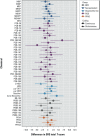Gestational exposure to endocrine-disrupting chemicals and reciprocal social, repetitive, and stereotypic behaviors in 4- and 5-year-old children: the HOME study
- PMID: 24622245
- PMCID: PMC4014765
- DOI: 10.1289/ehp.1307261
Gestational exposure to endocrine-disrupting chemicals and reciprocal social, repetitive, and stereotypic behaviors in 4- and 5-year-old children: the HOME study
Abstract
Background: Endocrine-disrupting chemicals (EDCs) may be involved in the etiology of autism spectrum disorders, but identifying relevant chemicals within mixtures of EDCs is difficult.
Objective: Our goal was to identify gestational EDC exposures associated with autistic behaviors.
Methods: We measured the concentrations of 8 phthalate metabolites, bisphenol A, 25 polychlorinated biphenyls (PCBs), 6 organochlorine pesticides, 8 brominated flame retardants, and 4 perfluoroalkyl substances in blood or urine samples from 175 pregnant women in the HOME (Health Outcomes and Measures of the Environment) Study (Cincinnati, OH). When children were 4 and 5 years old, mothers completed the Social Responsiveness Scale (SRS), a measure of autistic behaviors. We examined confounder-adjusted associations between 52 EDCs and SRS scores using a two-stage hierarchical analysis to account for repeated measures and confounding by correlated EDCs.
Results: Most of the EDCs were associated with negligible absolute differences in SRS scores (≤ 1.5). Each 2-SD increase in serum concentrations of polybrominated diphenyl ether-28 (PBDE-28) (β = 2.5; 95% CI: -0.6, 5.6) or trans-nonachlor (β = 4.1; 95% CI: 0.8-7.3) was associated with more autistic behaviors. In contrast, fewer autistic behaviors were observed among children born to women with detectable versus nondetectable concentrations of PCB-178 (β = -3.0; 95% CI: -6.3, 0.2), β-hexachlorocyclohexane (β = -3.3; 95% CI: -6.1, -0.5), or PBDE-85 (β = -3.2; 95% CI: -5.9, -0.5). Increasing perfluorooctanoate (PFOA) concentrations were also associated with fewer autistic behaviors (β = -2.0; 95% CI: -4.4, 0.4).
Conclusions: Some EDCs were associated with autistic behaviors in this cohort, but our modest sample size precludes us from dismissing chemicals with null associations. PFOA, β-hexachlorocyclohexane, PCB-178, PBDE-28, PBDE-85, and trans-nonachlor deserve additional scrutiny as factors that may be associated with childhood autistic behaviors.
Conflict of interest statement
The findings and conclusions in this report are those of the authors and do not necessarily represent the official position of the CDC.
B.P.L. has served as an expert witness and as a consultant to the California Attorney General’s Office, but he has not personally received any compensation for these services. B.P.L. has also served as a paid consultant on a U.S. Environmental Protection Agency research study. J.M.B. was financially compensated for conducting a re-analysis of the international pooled study of lead exposure for the plaintiffs in a public nuisance case.
The authors declare they have no actual or potential competing financial interests.
Figures


Comment in
-
Clues to autistic behaviors: exploring the role of endocrine disruptors.Environ Health Perspect. 2014 May;122(5):A137. doi: 10.1289/ehp.122-A137. Environ Health Perspect. 2014. PMID: 24784413 Free PMC article. No abstract available.
References
-
- American Psychiatric Association. Washington, DC: American Psychiatric Association; 2000. Diagnostic and Statistical Manual of Mental Disorders: DSM-IV-TR. 4th ed.
-
- Beck AT, Steer RA, Brown GK. 1996. Beck Depression Inventory–2nd Edition (BDI-II). San Antonio, TX:Psychological Corporation.
-
- Bellinger DC. What is an adverse effect? A possible resolution of clinical and epidemiological perspectives on neurobehavioral toxicity. Environ Res. 2004;95(3):394–405. - PubMed
-
- Bolte S, Poustka F, Constantino JN. Assessing autistic traits: cross-cultural validation of the social responsiveness scale (SRS). Autism Res. 2008;1(6):354–363. - PubMed
Publication types
MeSH terms
Substances
Grants and funding
LinkOut - more resources
Full Text Sources
Other Literature Sources
Medical

